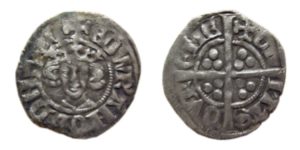Biographies of Jews at the Tower of London
Edward I clipped coin
A new project into the Jewish history of the Tower of London has now launched online. Some 236 biographies of Jewish prisoners, refugees, and workers at the Tower have been compiled by researchers at Historic Royal Palaces as part of the charity’s drive to uncover more diverse stories about the sites in its care.
Along with evidence of Jewish businesswomen, cross-community collaboration, and even a Jewish sergeant working at the Tower, the biographies also include fascinating examples of medieval Jewish immigration to England from Germany. There were at least two German Jewish prisoners held at the Tower in the late 1270s: Jacob of Hammerstein and the rabbi Josce of Wallingford.

From the manuscript accounts of the Constable of the Tower of London from 1288 to 1301. The passage here is from the account for 1289 to 1290, which records the Constable receiving £23 6s in customs from 1335 Jews crossing from London to Wissant at the Expulsion in 1290, each Jew paying 4d, and a further 126 poor Jews, each paying 2d.
© The National Archives, E 101/4/25, m. 3
Jacob of Hammerstein
Jacob’s name suggests that he was German or had German origins. There were other German Jews in London at this time. An Abraham of Germany was fined by one of the Tower sergeants in the late 1270s.
Jacob paid the sergeant 13s 4d sometime between 20 January 1275 and 8 June 1277 for a certain unspecified allegation that he was accused of. He was imprisoned in the Tower by sometime after 13 June that year, when the sergeant’s roll records Jacob paying 2s for gates, meaning permission to move about the Tower precinct. He later twice paid 6d for an unspecified trespass and 6d as a fine. The date of his imprisonment coincides with the mass incarceration of England’s Jews for coin-clipping in the late 1270s, and this may have been what he was accused of.
He was still alive by Easter 1280, when he was mainpernor (stood bail) for Chera, the widow of Cresse son of Master Elias. As he could not produce Chera before the court, he and her other mainpernor, Solomon the Welsh, were fined 1 mark.

Edward I clipped coin
Josce of Wallingford
A German rabbi, Josce resided in Southampton by 1274, when he and a Solomon son of Solomon paid the king 4 bezants for permission to live there. He later moved to Wallingford and served on a commission of inquiry in London in 1275. He also practiced mysticism. Along with the London rabbi Elias son of Master Moses, Josce taught a student called Marcus a magical formula to recite over a plant to discover the answers to questions.
In January/February 1278, Josce was arrested along with his wife Belasez and a Contessa of Oxford. All three of them were accused of coin-clipping, but the records do not show what the result of the case was. In May that year, Josce was arrested a second time. He was charged with entering the house of Peter of Witton in Wallingford and carrying away £10-worth of goods, but the jurors testified that Josce was innocent of theft. Instead, Peter’s wife had sold these goods to Josce without her husband’s knowledge. Josce was ordered to repay Peter and was to be imprisoned until he could find guarantees for this. In June/July, Peter again sued Josce on the same charges.
We know from a later court case that Josce was eventually imprisoned in the Tower, though it is unclear if this was for the accusation of coin-clipping or his debt to Peter of Witton. In 1279, a Roger of Weymouth was tried on a charge of stealing a mazer cup (a kind of wooden drinking bowl). He claimed that it had been given to him by Josce of Wallingford for the services Roger did him while Josce was held at the Tower. But when Josce was brought to court and Roger failed to recognise him, Roger was sent to the pillory.
Jacob and Josce’s stories, along with 234 others, can now be found at the following link: https://www.hrp.org.uk/about-us/research/the-jewish-history-of-the-medieval-tower-of-london/
– Dr Rory Maclellan
Hidden Treasures: Celebrating the documents, photos and artefacts in British archives that tell the story of Jews in Britain